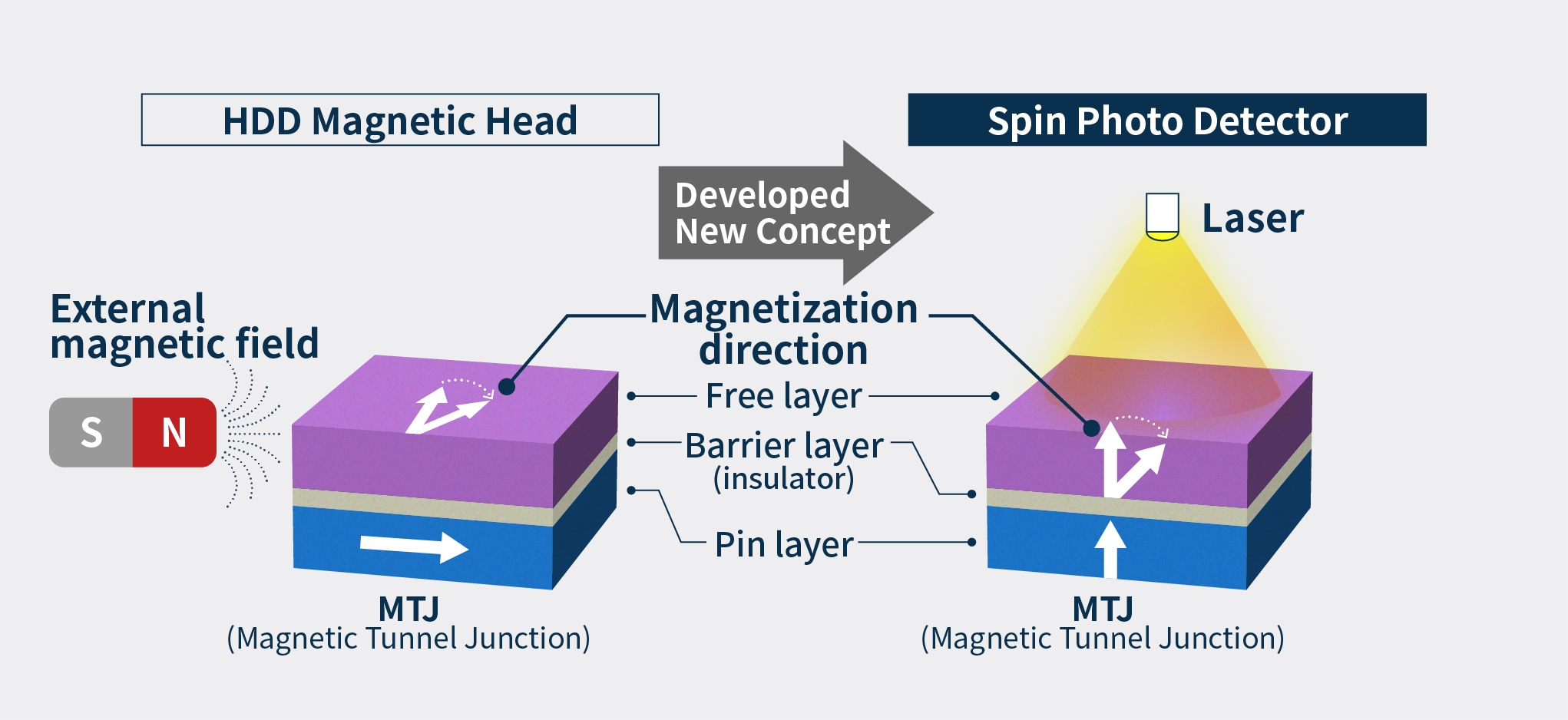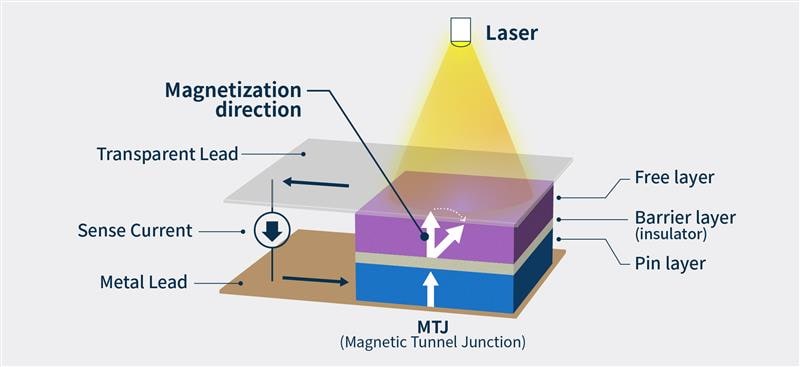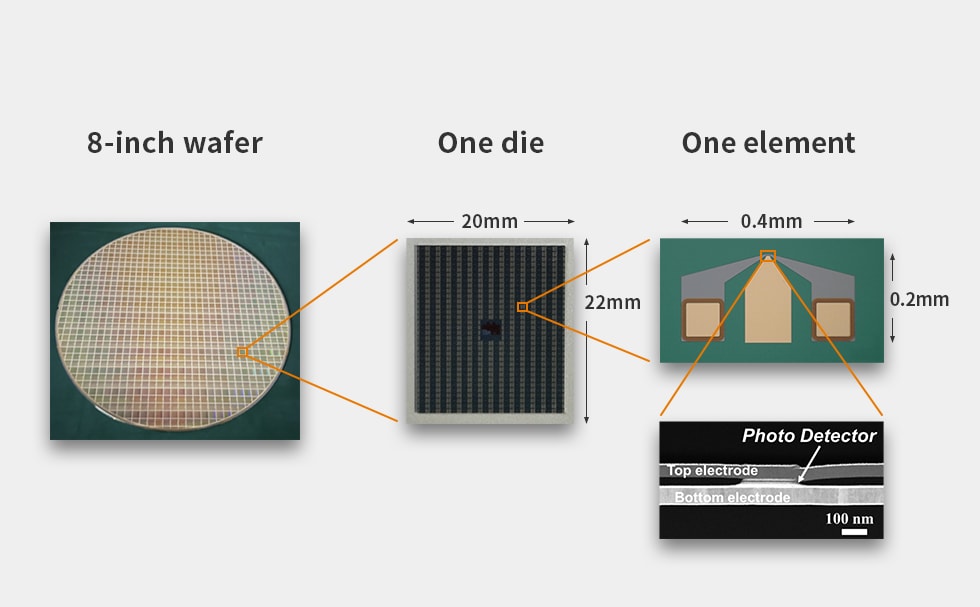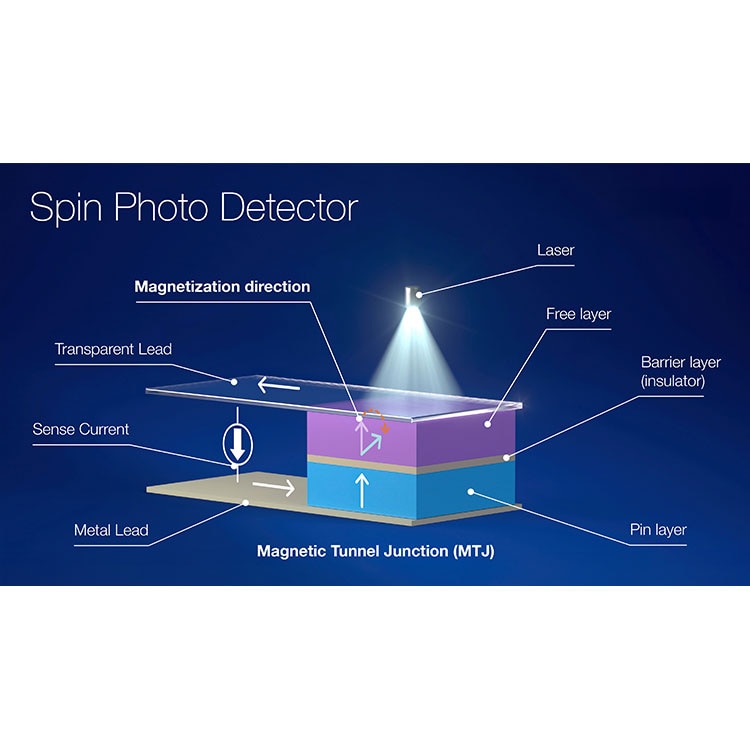

From Semiconductors to Magnetism: Ultra-Fast Spin Photo Detector Revolutionizes Light Detection
Demand for high-speed optical communication and interconnects is soaring in fields like generative AI, data centers, and Beyond 5G/6G. As the industry seeks technological innovations in optical devices, TDK, in collaboration with Nihon University in Japan, has successfully demonstrated the Spin Photo Detector—the world’s first high-speed light detection element based on a magnetic device. Unlike conventional semiconductor photo detectors, this groundbreaking device doesn’t rely on semiconductors. It is poised to become a key enabler of generative AI and Beyond 5G/6G, where optical communication and interconnects are expected to play critical roles.
Technological challenges of optical communication in the age of generative AI and Beyond 5G/6G
The momentum of generative AI—an umbrella term for AI technologies capable of autonomously creating text, images, and audio—has been unstoppable ever since ChatGPT, the conversational AI service, opened its floodgates in 2022. Tech giants and startups alike are rushing to develop generative AI tools, sparking a global race for innovation and driving rapid adoption in all corners of society.
At the heart of this technological revolution lies the need for advances in optical communication, both wireless and wired. Today, generative AI largely runs on graphics processing units (GPUs)*1, specialized processors originally designed for high-performance image processing. To tie together vast networks of GPUs at high speeds, high-performance optical communication is becoming indispensable, necessitating a shift away from conventional electrical wiring.
Optical communication is also vital for Beyond 5G/6G, the next generation of telecommunication standards. Optical fiber*2 transmission has been in full-scale practical use since the 1980s and has undergone extraordinary advancements, enabling ultra-high-speed, high-capacity communication. Today, optical fiber networks can handle real-world data rates as high as 10 to 20 Tbps per fiber. 6G, however, will require speeds exceeding 100 Tbps per fiber, achievable only with further technological breakthroughs.
Meanwhile, wireless communication has traditionally evolved around radio waves, such as centimeter and millimeter waves. Utilizing optical signals would theoretically enable ultra-high-capacity, low-latency communication topping 1 Tbps, unlocking tremendous progress in data-intensive applications like linking personal devices with data centers when using generative AI and powering AI-enabled smart glasses. This is why technological innovation in optical communication—both wired and wireless—needs to continue.
Photonic integrated circuit market forecast

As optical communication continues to advance, one technology garnering significant attention is the photo detector*3—an elementary device that detects light by converting optical signals into electrical counterparts. Photo detectors are core components in optical communication receivers, ensuring incoming light is rapidly and accurately transformed into electrical signals. They play a key role in photoelectric conversion, handling optical and electrical signals within extremely compact packages. Conventional photo detectors based on semiconductor diodes, however, are constrained by an inherent trade-off: achieving higher speeds requires reducing the detector size but incurs the cost of lower sensitivity.
Conventional semiconductor photo detectors bear another fundamental limitation: their sensitivity decreases as the light’s wavelength shortens. While they perform well in the infrared (1,300 to 1,600 nm) range, their sensitivity drops significantly for visible light (400 to 700 nm). This means shrinking the device size—a common method for increasing speed—is not a viable option in the realm of visible light. Due to such limitations of physics, high-speed optical communication and interconnects using short-wavelength light had been practically unachievable.
Worse, photo detectors based on semiconductor diodes require a single-crystal substrate, imposing significant constraints on their integration into various systems. From an engineering standpoint, this has hindered the development of compact optical communication and interconnects using co-packaged optics (CPO), a technology considered essential to the rising prominence of photoelectric conversion.
Spin Photo Detector: an entirely new light detector based on magnetic elements
In response to these challenges, TDK has developed the Spin Photo Detector, a revolutionary photo detector that achieves ultra-high-speed light sensing using a magnetic element instead of conventional semiconductors. Built using Magnetic Tunnel Junction (MTJ)*4 technology—originally pioneered by TDK for HDD magnetic heads and TMR magnetic sensors—this novel detector enables ultra-high-speed optical detection across a broad spectrum, from infrared to visible light—a feat difficult to achieve with semiconductors.
Another notable advantage is its compact size and versatility in integrating with various optical devices. Unlike conventional semiconductor-based detectors, which require a substrate, the Spin Photo Detector can be directly integrated onto photonic integrated circuits (PICs)*5 and a variety of substrates, delivering exceptional performance in optical devices requiring ultra-fast detection.
Spin Photo Detector leverages HDD head technologies

Because the Spin Photo Detector can serve both wireless and wired applications while covering a broad spectrum, its potential utility extends to smart glasses, ultra-high-speed image sensors, and spectroscopic specimen analyzers—in addition to generative AI and Beyond 5G/6G. Its ability to function even in environments exposed to cosmic radiation opens new frontiers for innovation.
Semiconductor photo detectors and Spin Photo Detector compared

Internal structure of the Spin Photo Detector

From semiconductors to magnetism: the future of photo detectors
Tetsuya Shibata of the Applied Products Development Center at TDK Corporation’s Technology & Intellectual Property Headquarters commented on the Spin Photo Detector’s outlook. “The Spin Photo Detector is a groundbreaking photo detector that doesn’t use semiconductors, functioning on an entirely new principle based on magnetism. We turned conventional wisdom on its head. I believe it even has the potential to alleviate the global semiconductor shortage we face today. Because it leverages TDK’s existing wafer process technologies developed for HDD heads, we already have an established foundation for its manufacturing process. This will allow us to support our customers looking to solve their problems quickly.”


Professor Arata Tsukamoto of Nihon University, TDK’s joint research partner, also shared his views. “I believe the spin photo detector holds remarkable promise, both from a scientific and technological perspective. Its foundation lies in the ‘spin’ of electrons inside solids—the origin of magnetism—and its ultrafast response to light, accompanied by electrical conversion enabled by the MTJ (Magnetic Tunnel Junction) structure. This unprecedented photoelectric conversion device, grounded in a novel interplay of light, magnetism, and electricity, is sure to usher in a new paradigm and drive breakthrough innovations.”
With the introduction of the Spin Photo Detector, TDK is set to underpin the next generation of optical communication technologies, accelerating advancements in Beyond 5G/6G, generative AI, and the broader digital transformation (DX) landscape.
Spin Photo Detector

Terminology
- GPU: Short for Graphics Processing Unit. Specialized electronic circuit originally designed for image processing and acceleration of computer graphics.
- Optical fiber: A fiber made of glass or plastic used as a light transmission path. It is lightweight, not easily affected by electromagnetism, and can transmit signals at high speeds over long distances.
- Photo detector: Also called a photodiode.
- MTJ: Short for Magnetic Tunnel Junction. An element that utilizes the tunnel magnetoresistance (TMR) effect.
- PIC: Short for Photonic Integrated Circuit, which uses both electricity and light for signal transmission instead of just electricity.















